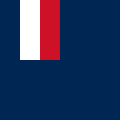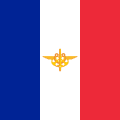French Empire Empire français | |
|---|---|
 Flags were used to represent various territories and colonies across the Empire |
| List of French flags |
|---|
 |
Some colonies, protectorates and mandates of the French Colonial Empire used distinctive colonial flags. These most commonly had a French Tricolour in the canton.
Contents
- Colonial flags with a tricolour canton
- Red field
- Blue field
- White field
- Green field
- Yellow field
- Multicolour field
- Colonial flags with other designs
- Modified tricolours
- Other designs
- Galleries
- Historical flags
- Flags with French history
- Current official and unofficial flags of French overseas regions, collectivities, and territories
- Current subnational flags of overseas collectivities and territories
- Other official flags
- See also
- References
As well as the flags of individual colonies, the governors-general of French colonies flew a square flag with a blue field and the French ensign in the canton. This flag was flown beneath the national ensign. Colonial governors used a rectangular swallow-tailed version of this flag.






















































































































